Global Logistics and Supply Chain Management: Nestle Case Study Report
VerifiedAdded on 2022/08/18
|19
|4729
|16
Report
AI Summary
This report provides a comprehensive analysis of Nestle's global logistics and supply chain management. It begins with an executive summary and company background, highlighting Nestle's position in the food and beverage industry and its global presence. A literature review establishes the significance of supply chain management, followed by a critical analysis of Nestle's current performance, including product design, process design, planning, quality management, distribution, and IT innovation. The report identifies challenges faced by Nestle, such as raw material shortages and IT infrastructure disruptions, and compares its supply chain strategy with that of Kraft Heinz. Recommendations are provided to improve Nestle's supply chain management, and the report concludes with a summary of key findings and references.
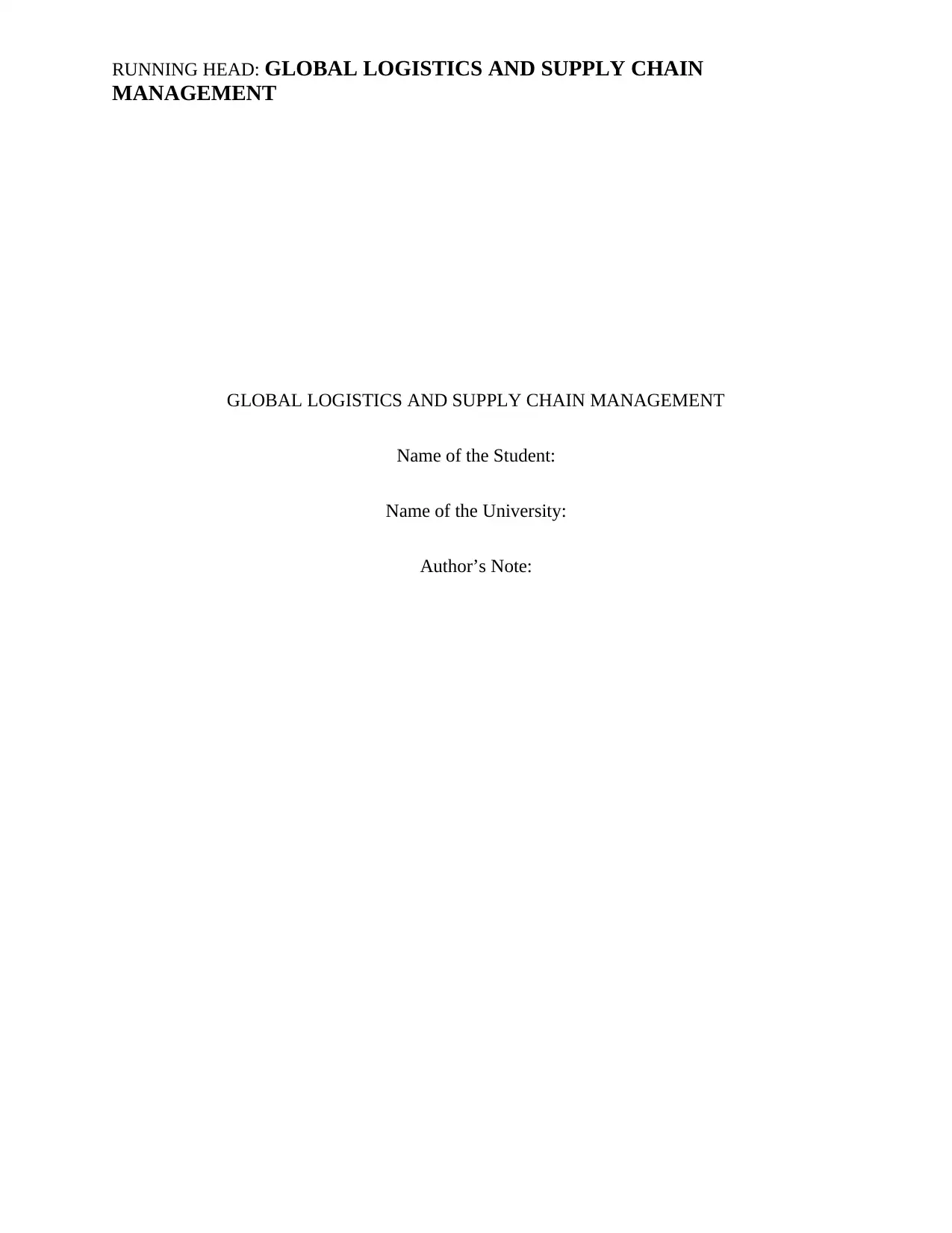
RUNNING HEAD: GLOBAL LOGISTICS AND SUPPLY CHAIN
MANAGEMENT
GLOBAL LOGISTICS AND SUPPLY CHAIN MANAGEMENT
Name of the Student:
Name of the University:
Author’s Note:
MANAGEMENT
GLOBAL LOGISTICS AND SUPPLY CHAIN MANAGEMENT
Name of the Student:
Name of the University:
Author’s Note:
Paraphrase This Document
Need a fresh take? Get an instant paraphrase of this document with our AI Paraphraser
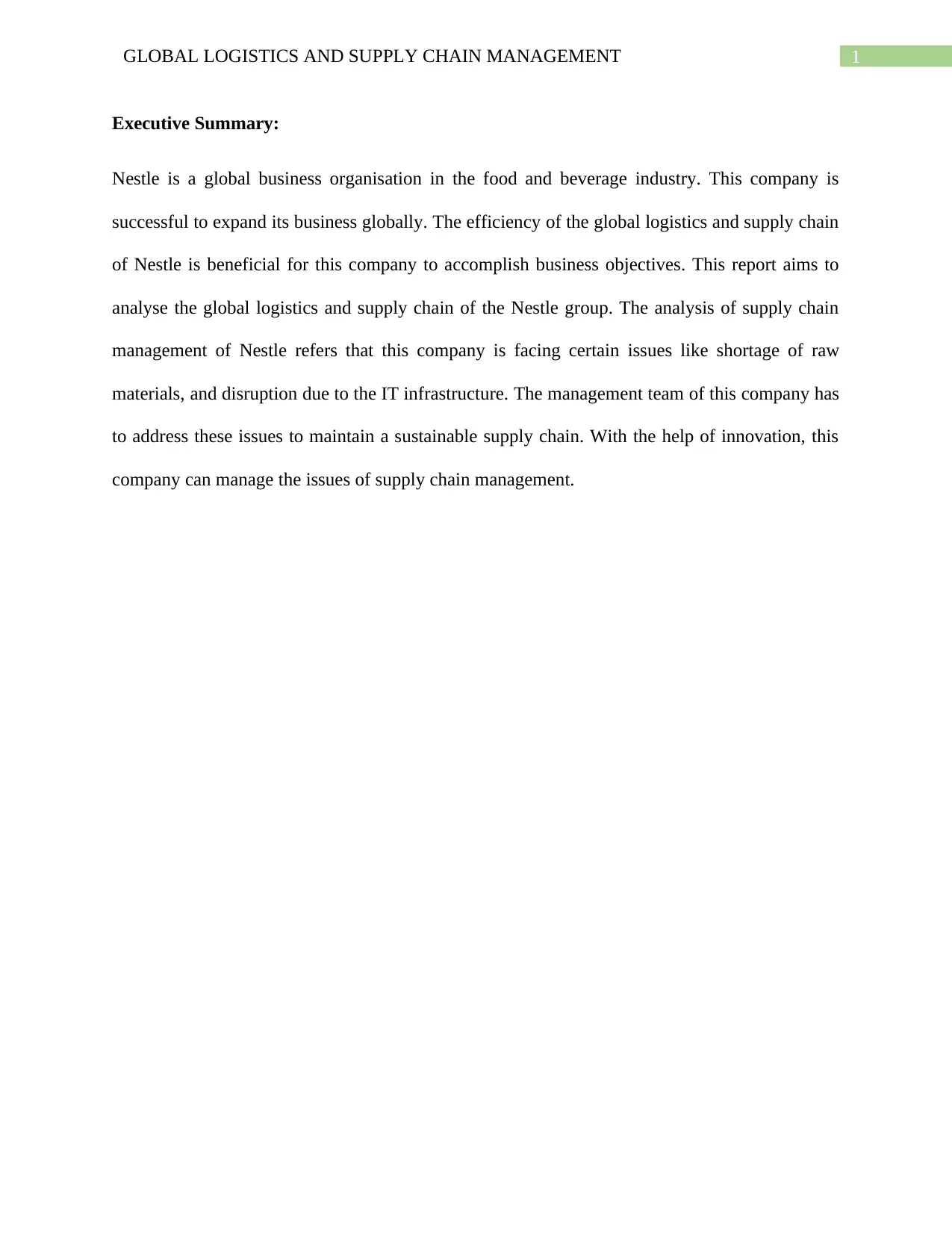
1GLOBAL LOGISTICS AND SUPPLY CHAIN MANAGEMENT
Executive Summary:
Nestle is a global business organisation in the food and beverage industry. This company is
successful to expand its business globally. The efficiency of the global logistics and supply chain
of Nestle is beneficial for this company to accomplish business objectives. This report aims to
analyse the global logistics and supply chain of the Nestle group. The analysis of supply chain
management of Nestle refers that this company is facing certain issues like shortage of raw
materials, and disruption due to the IT infrastructure. The management team of this company has
to address these issues to maintain a sustainable supply chain. With the help of innovation, this
company can manage the issues of supply chain management.
Executive Summary:
Nestle is a global business organisation in the food and beverage industry. This company is
successful to expand its business globally. The efficiency of the global logistics and supply chain
of Nestle is beneficial for this company to accomplish business objectives. This report aims to
analyse the global logistics and supply chain of the Nestle group. The analysis of supply chain
management of Nestle refers that this company is facing certain issues like shortage of raw
materials, and disruption due to the IT infrastructure. The management team of this company has
to address these issues to maintain a sustainable supply chain. With the help of innovation, this
company can manage the issues of supply chain management.
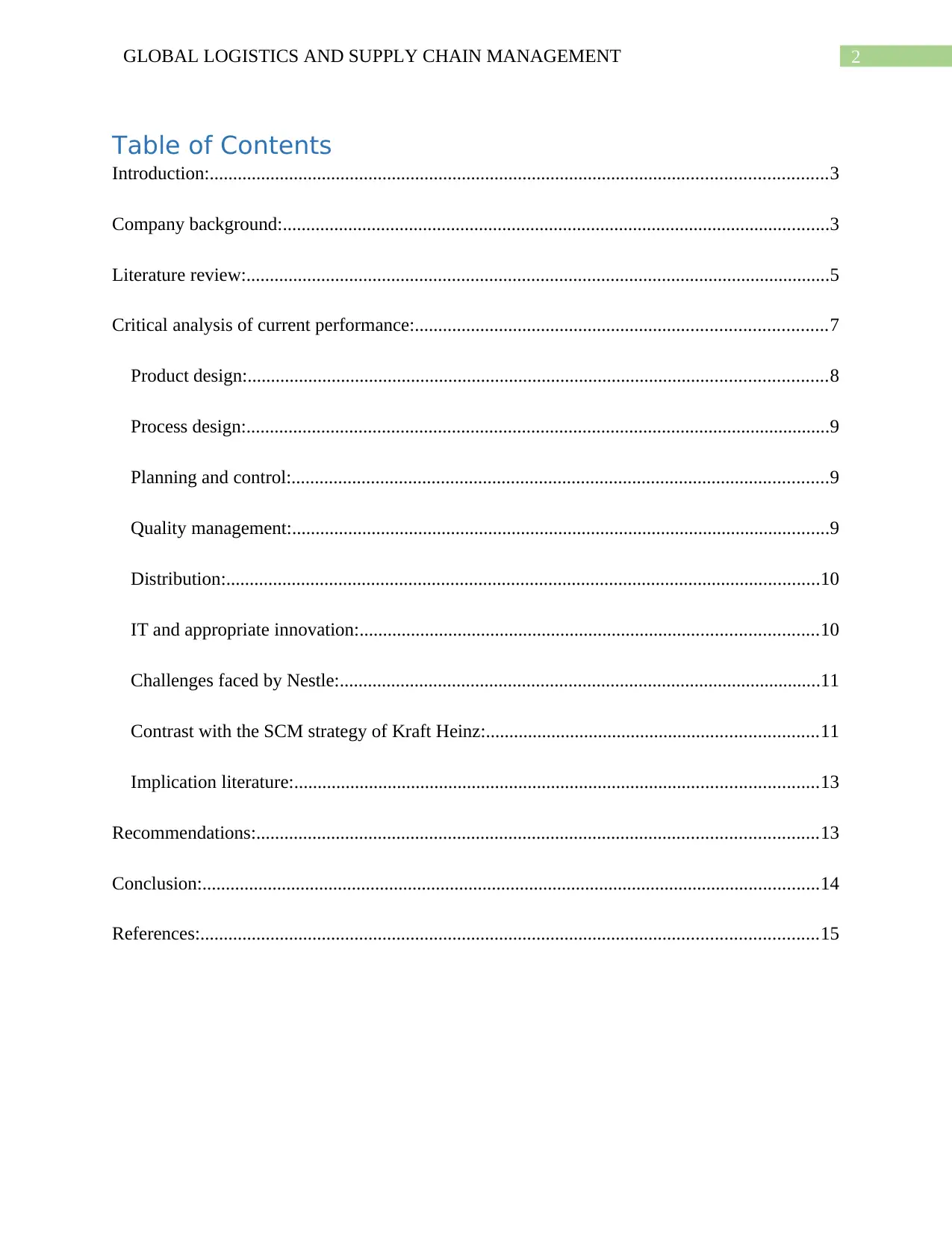
2GLOBAL LOGISTICS AND SUPPLY CHAIN MANAGEMENT
Table of Contents
Introduction:....................................................................................................................................3
Company background:.....................................................................................................................3
Literature review:.............................................................................................................................5
Critical analysis of current performance:........................................................................................7
Product design:............................................................................................................................8
Process design:.............................................................................................................................9
Planning and control:...................................................................................................................9
Quality management:...................................................................................................................9
Distribution:...............................................................................................................................10
IT and appropriate innovation:..................................................................................................10
Challenges faced by Nestle:.......................................................................................................11
Contrast with the SCM strategy of Kraft Heinz:.......................................................................11
Implication literature:................................................................................................................13
Recommendations:........................................................................................................................13
Conclusion:....................................................................................................................................14
References:....................................................................................................................................15
Table of Contents
Introduction:....................................................................................................................................3
Company background:.....................................................................................................................3
Literature review:.............................................................................................................................5
Critical analysis of current performance:........................................................................................7
Product design:............................................................................................................................8
Process design:.............................................................................................................................9
Planning and control:...................................................................................................................9
Quality management:...................................................................................................................9
Distribution:...............................................................................................................................10
IT and appropriate innovation:..................................................................................................10
Challenges faced by Nestle:.......................................................................................................11
Contrast with the SCM strategy of Kraft Heinz:.......................................................................11
Implication literature:................................................................................................................13
Recommendations:........................................................................................................................13
Conclusion:....................................................................................................................................14
References:....................................................................................................................................15
⊘ This is a preview!⊘
Do you want full access?
Subscribe today to unlock all pages.

Trusted by 1+ million students worldwide
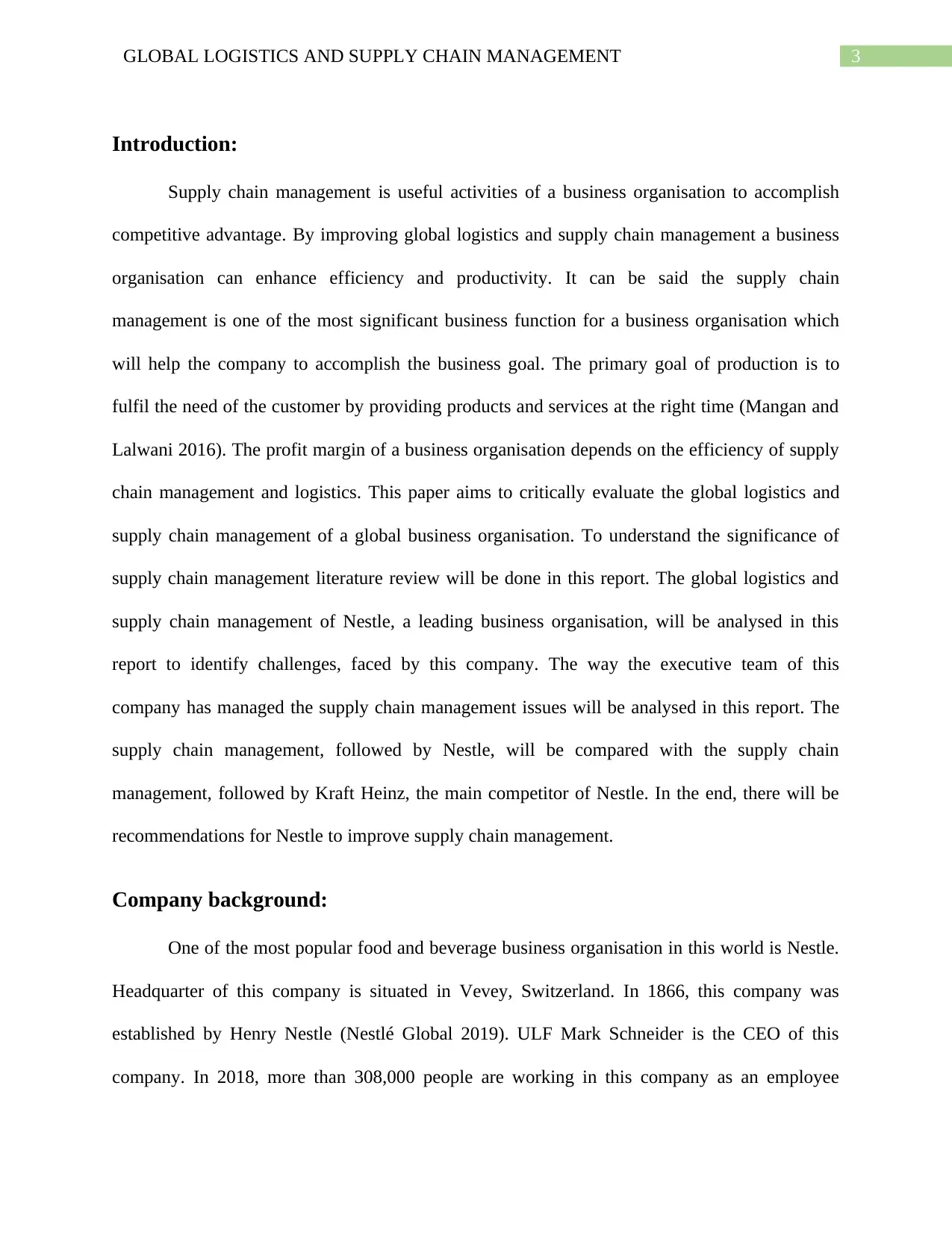
3GLOBAL LOGISTICS AND SUPPLY CHAIN MANAGEMENT
Introduction:
Supply chain management is useful activities of a business organisation to accomplish
competitive advantage. By improving global logistics and supply chain management a business
organisation can enhance efficiency and productivity. It can be said the supply chain
management is one of the most significant business function for a business organisation which
will help the company to accomplish the business goal. The primary goal of production is to
fulfil the need of the customer by providing products and services at the right time (Mangan and
Lalwani 2016). The profit margin of a business organisation depends on the efficiency of supply
chain management and logistics. This paper aims to critically evaluate the global logistics and
supply chain management of a global business organisation. To understand the significance of
supply chain management literature review will be done in this report. The global logistics and
supply chain management of Nestle, a leading business organisation, will be analysed in this
report to identify challenges, faced by this company. The way the executive team of this
company has managed the supply chain management issues will be analysed in this report. The
supply chain management, followed by Nestle, will be compared with the supply chain
management, followed by Kraft Heinz, the main competitor of Nestle. In the end, there will be
recommendations for Nestle to improve supply chain management.
Company background:
One of the most popular food and beverage business organisation in this world is Nestle.
Headquarter of this company is situated in Vevey, Switzerland. In 1866, this company was
established by Henry Nestle (Nestlé Global 2019). ULF Mark Schneider is the CEO of this
company. In 2018, more than 308,000 people are working in this company as an employee
Introduction:
Supply chain management is useful activities of a business organisation to accomplish
competitive advantage. By improving global logistics and supply chain management a business
organisation can enhance efficiency and productivity. It can be said the supply chain
management is one of the most significant business function for a business organisation which
will help the company to accomplish the business goal. The primary goal of production is to
fulfil the need of the customer by providing products and services at the right time (Mangan and
Lalwani 2016). The profit margin of a business organisation depends on the efficiency of supply
chain management and logistics. This paper aims to critically evaluate the global logistics and
supply chain management of a global business organisation. To understand the significance of
supply chain management literature review will be done in this report. The global logistics and
supply chain management of Nestle, a leading business organisation, will be analysed in this
report to identify challenges, faced by this company. The way the executive team of this
company has managed the supply chain management issues will be analysed in this report. The
supply chain management, followed by Nestle, will be compared with the supply chain
management, followed by Kraft Heinz, the main competitor of Nestle. In the end, there will be
recommendations for Nestle to improve supply chain management.
Company background:
One of the most popular food and beverage business organisation in this world is Nestle.
Headquarter of this company is situated in Vevey, Switzerland. In 1866, this company was
established by Henry Nestle (Nestlé Global 2019). ULF Mark Schneider is the CEO of this
company. In 2018, more than 308,000 people are working in this company as an employee
Paraphrase This Document
Need a fresh take? Get an instant paraphrase of this document with our AI Paraphraser
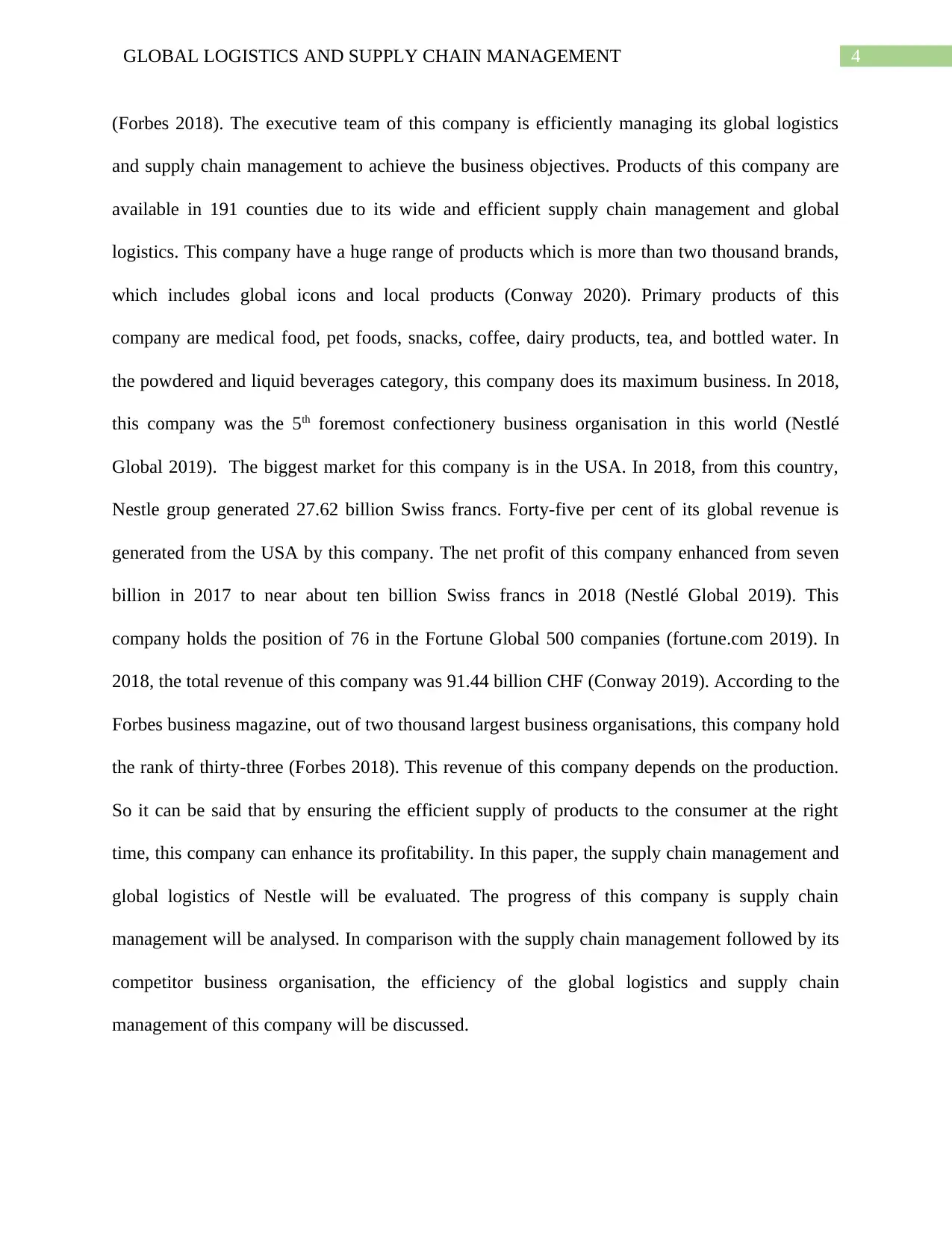
4GLOBAL LOGISTICS AND SUPPLY CHAIN MANAGEMENT
(Forbes 2018). The executive team of this company is efficiently managing its global logistics
and supply chain management to achieve the business objectives. Products of this company are
available in 191 counties due to its wide and efficient supply chain management and global
logistics. This company have a huge range of products which is more than two thousand brands,
which includes global icons and local products (Conway 2020). Primary products of this
company are medical food, pet foods, snacks, coffee, dairy products, tea, and bottled water. In
the powdered and liquid beverages category, this company does its maximum business. In 2018,
this company was the 5th foremost confectionery business organisation in this world (Nestlé
Global 2019). The biggest market for this company is in the USA. In 2018, from this country,
Nestle group generated 27.62 billion Swiss francs. Forty-five per cent of its global revenue is
generated from the USA by this company. The net profit of this company enhanced from seven
billion in 2017 to near about ten billion Swiss francs in 2018 (Nestlé Global 2019). This
company holds the position of 76 in the Fortune Global 500 companies (fortune.com 2019). In
2018, the total revenue of this company was 91.44 billion CHF (Conway 2019). According to the
Forbes business magazine, out of two thousand largest business organisations, this company hold
the rank of thirty-three (Forbes 2018). This revenue of this company depends on the production.
So it can be said that by ensuring the efficient supply of products to the consumer at the right
time, this company can enhance its profitability. In this paper, the supply chain management and
global logistics of Nestle will be evaluated. The progress of this company is supply chain
management will be analysed. In comparison with the supply chain management followed by its
competitor business organisation, the efficiency of the global logistics and supply chain
management of this company will be discussed.
(Forbes 2018). The executive team of this company is efficiently managing its global logistics
and supply chain management to achieve the business objectives. Products of this company are
available in 191 counties due to its wide and efficient supply chain management and global
logistics. This company have a huge range of products which is more than two thousand brands,
which includes global icons and local products (Conway 2020). Primary products of this
company are medical food, pet foods, snacks, coffee, dairy products, tea, and bottled water. In
the powdered and liquid beverages category, this company does its maximum business. In 2018,
this company was the 5th foremost confectionery business organisation in this world (Nestlé
Global 2019). The biggest market for this company is in the USA. In 2018, from this country,
Nestle group generated 27.62 billion Swiss francs. Forty-five per cent of its global revenue is
generated from the USA by this company. The net profit of this company enhanced from seven
billion in 2017 to near about ten billion Swiss francs in 2018 (Nestlé Global 2019). This
company holds the position of 76 in the Fortune Global 500 companies (fortune.com 2019). In
2018, the total revenue of this company was 91.44 billion CHF (Conway 2019). According to the
Forbes business magazine, out of two thousand largest business organisations, this company hold
the rank of thirty-three (Forbes 2018). This revenue of this company depends on the production.
So it can be said that by ensuring the efficient supply of products to the consumer at the right
time, this company can enhance its profitability. In this paper, the supply chain management and
global logistics of Nestle will be evaluated. The progress of this company is supply chain
management will be analysed. In comparison with the supply chain management followed by its
competitor business organisation, the efficiency of the global logistics and supply chain
management of this company will be discussed.
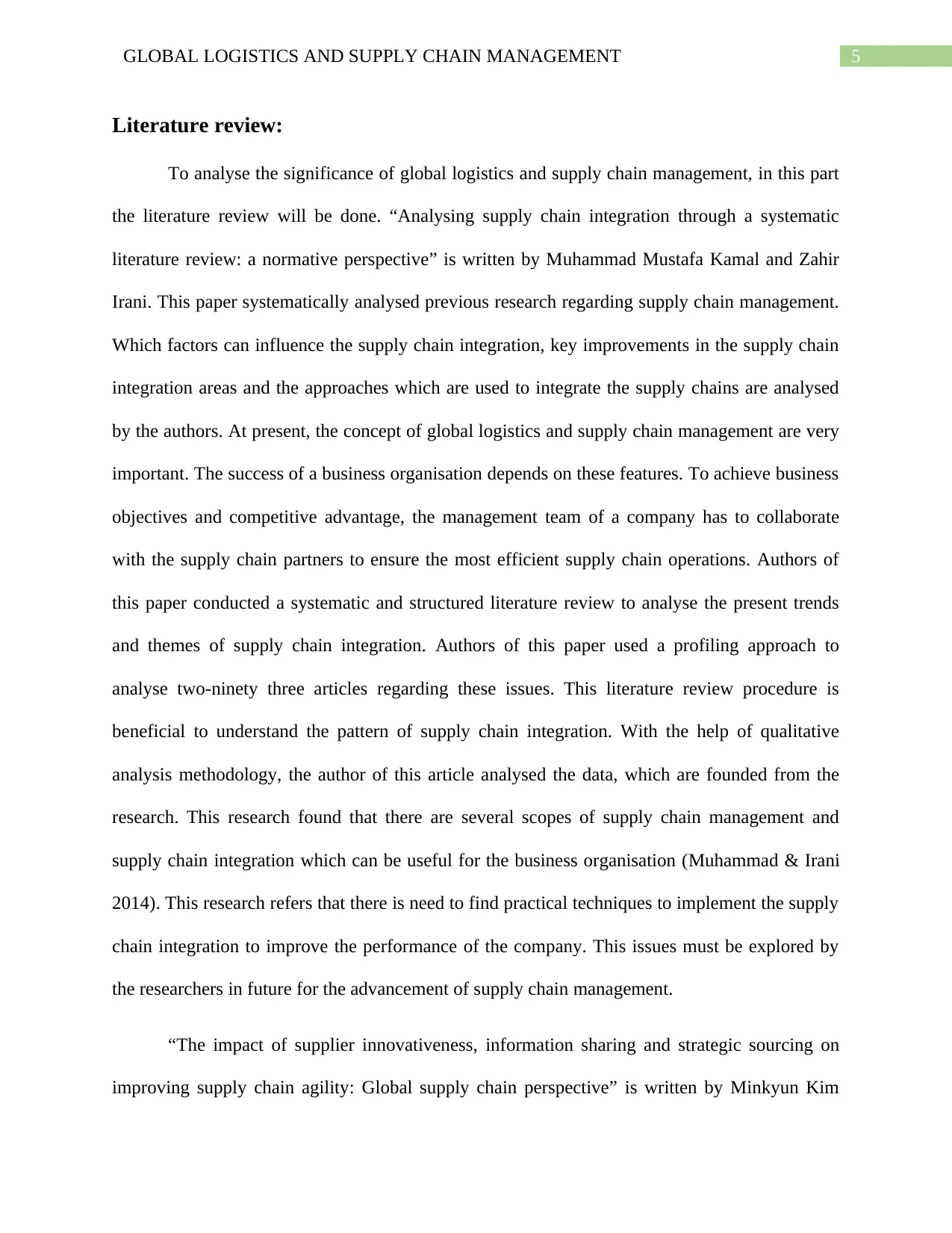
5GLOBAL LOGISTICS AND SUPPLY CHAIN MANAGEMENT
Literature review:
To analyse the significance of global logistics and supply chain management, in this part
the literature review will be done. “Analysing supply chain integration through a systematic
literature review: a normative perspective” is written by Muhammad Mustafa Kamal and Zahir
Irani. This paper systematically analysed previous research regarding supply chain management.
Which factors can influence the supply chain integration, key improvements in the supply chain
integration areas and the approaches which are used to integrate the supply chains are analysed
by the authors. At present, the concept of global logistics and supply chain management are very
important. The success of a business organisation depends on these features. To achieve business
objectives and competitive advantage, the management team of a company has to collaborate
with the supply chain partners to ensure the most efficient supply chain operations. Authors of
this paper conducted a systematic and structured literature review to analyse the present trends
and themes of supply chain integration. Authors of this paper used a profiling approach to
analyse two-ninety three articles regarding these issues. This literature review procedure is
beneficial to understand the pattern of supply chain integration. With the help of qualitative
analysis methodology, the author of this article analysed the data, which are founded from the
research. This research found that there are several scopes of supply chain management and
supply chain integration which can be useful for the business organisation (Muhammad & Irani
2014). This research refers that there is need to find practical techniques to implement the supply
chain integration to improve the performance of the company. This issues must be explored by
the researchers in future for the advancement of supply chain management.
“The impact of supplier innovativeness, information sharing and strategic sourcing on
improving supply chain agility: Global supply chain perspective” is written by Minkyun Kim
Literature review:
To analyse the significance of global logistics and supply chain management, in this part
the literature review will be done. “Analysing supply chain integration through a systematic
literature review: a normative perspective” is written by Muhammad Mustafa Kamal and Zahir
Irani. This paper systematically analysed previous research regarding supply chain management.
Which factors can influence the supply chain integration, key improvements in the supply chain
integration areas and the approaches which are used to integrate the supply chains are analysed
by the authors. At present, the concept of global logistics and supply chain management are very
important. The success of a business organisation depends on these features. To achieve business
objectives and competitive advantage, the management team of a company has to collaborate
with the supply chain partners to ensure the most efficient supply chain operations. Authors of
this paper conducted a systematic and structured literature review to analyse the present trends
and themes of supply chain integration. Authors of this paper used a profiling approach to
analyse two-ninety three articles regarding these issues. This literature review procedure is
beneficial to understand the pattern of supply chain integration. With the help of qualitative
analysis methodology, the author of this article analysed the data, which are founded from the
research. This research found that there are several scopes of supply chain management and
supply chain integration which can be useful for the business organisation (Muhammad & Irani
2014). This research refers that there is need to find practical techniques to implement the supply
chain integration to improve the performance of the company. This issues must be explored by
the researchers in future for the advancement of supply chain management.
“The impact of supplier innovativeness, information sharing and strategic sourcing on
improving supply chain agility: Global supply chain perspective” is written by Minkyun Kim
⊘ This is a preview!⊘
Do you want full access?
Subscribe today to unlock all pages.

Trusted by 1+ million students worldwide
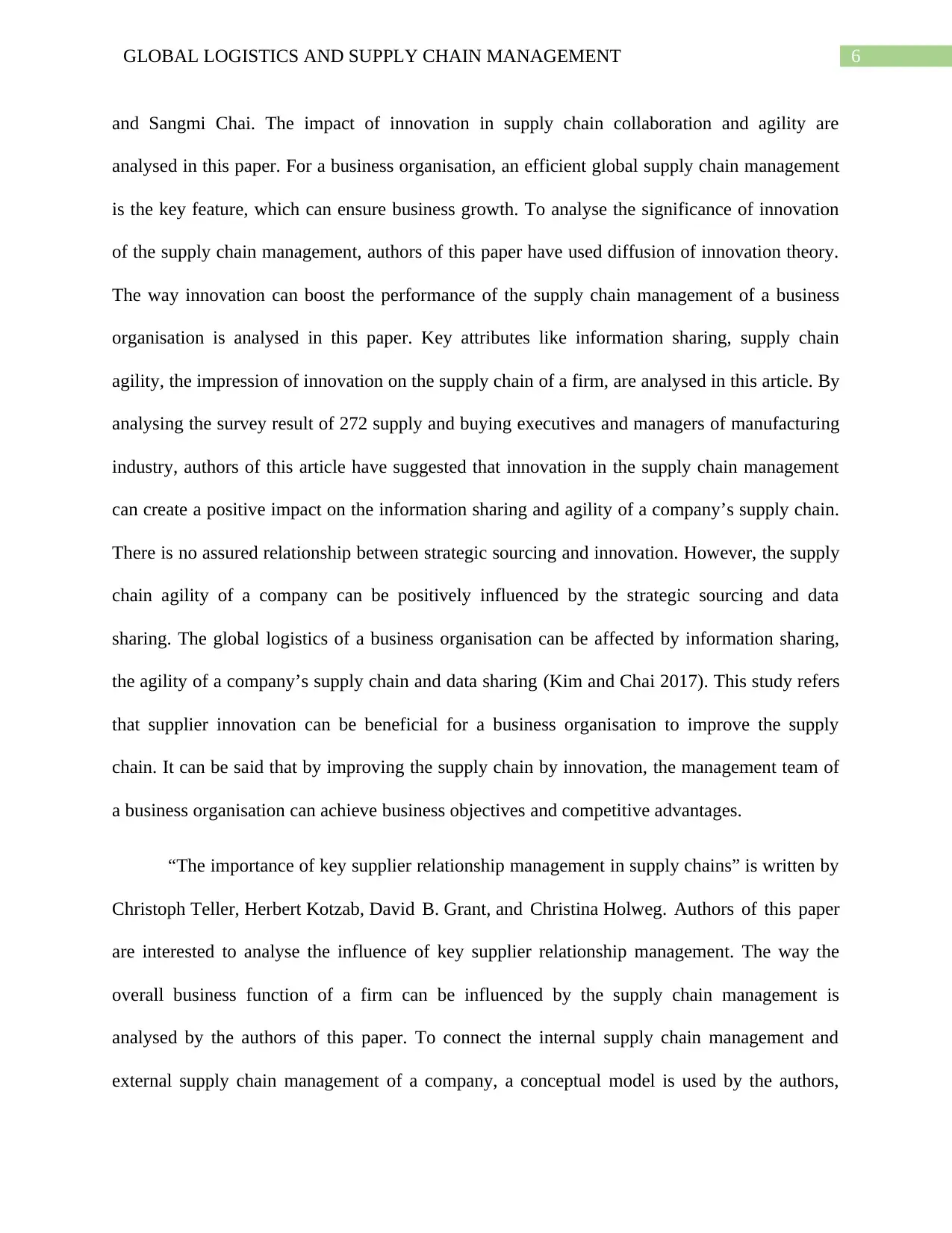
6GLOBAL LOGISTICS AND SUPPLY CHAIN MANAGEMENT
and Sangmi Chai. The impact of innovation in supply chain collaboration and agility are
analysed in this paper. For a business organisation, an efficient global supply chain management
is the key feature, which can ensure business growth. To analyse the significance of innovation
of the supply chain management, authors of this paper have used diffusion of innovation theory.
The way innovation can boost the performance of the supply chain management of a business
organisation is analysed in this paper. Key attributes like information sharing, supply chain
agility, the impression of innovation on the supply chain of a firm, are analysed in this article. By
analysing the survey result of 272 supply and buying executives and managers of manufacturing
industry, authors of this article have suggested that innovation in the supply chain management
can create a positive impact on the information sharing and agility of a company’s supply chain.
There is no assured relationship between strategic sourcing and innovation. However, the supply
chain agility of a company can be positively influenced by the strategic sourcing and data
sharing. The global logistics of a business organisation can be affected by information sharing,
the agility of a company’s supply chain and data sharing (Kim and Chai 2017). This study refers
that supplier innovation can be beneficial for a business organisation to improve the supply
chain. It can be said that by improving the supply chain by innovation, the management team of
a business organisation can achieve business objectives and competitive advantages.
“The importance of key supplier relationship management in supply chains” is written by
Christoph Teller, Herbert Kotzab, David B. Grant, and Christina Holweg. Authors of this paper
are interested to analyse the influence of key supplier relationship management. The way the
overall business function of a firm can be influenced by the supply chain management is
analysed by the authors of this paper. To connect the internal supply chain management and
external supply chain management of a company, a conceptual model is used by the authors,
and Sangmi Chai. The impact of innovation in supply chain collaboration and agility are
analysed in this paper. For a business organisation, an efficient global supply chain management
is the key feature, which can ensure business growth. To analyse the significance of innovation
of the supply chain management, authors of this paper have used diffusion of innovation theory.
The way innovation can boost the performance of the supply chain management of a business
organisation is analysed in this paper. Key attributes like information sharing, supply chain
agility, the impression of innovation on the supply chain of a firm, are analysed in this article. By
analysing the survey result of 272 supply and buying executives and managers of manufacturing
industry, authors of this article have suggested that innovation in the supply chain management
can create a positive impact on the information sharing and agility of a company’s supply chain.
There is no assured relationship between strategic sourcing and innovation. However, the supply
chain agility of a company can be positively influenced by the strategic sourcing and data
sharing. The global logistics of a business organisation can be affected by information sharing,
the agility of a company’s supply chain and data sharing (Kim and Chai 2017). This study refers
that supplier innovation can be beneficial for a business organisation to improve the supply
chain. It can be said that by improving the supply chain by innovation, the management team of
a business organisation can achieve business objectives and competitive advantages.
“The importance of key supplier relationship management in supply chains” is written by
Christoph Teller, Herbert Kotzab, David B. Grant, and Christina Holweg. Authors of this paper
are interested to analyse the influence of key supplier relationship management. The way the
overall business function of a firm can be influenced by the supply chain management is
analysed by the authors of this paper. To connect the internal supply chain management and
external supply chain management of a company, a conceptual model is used by the authors,
Paraphrase This Document
Need a fresh take? Get an instant paraphrase of this document with our AI Paraphraser
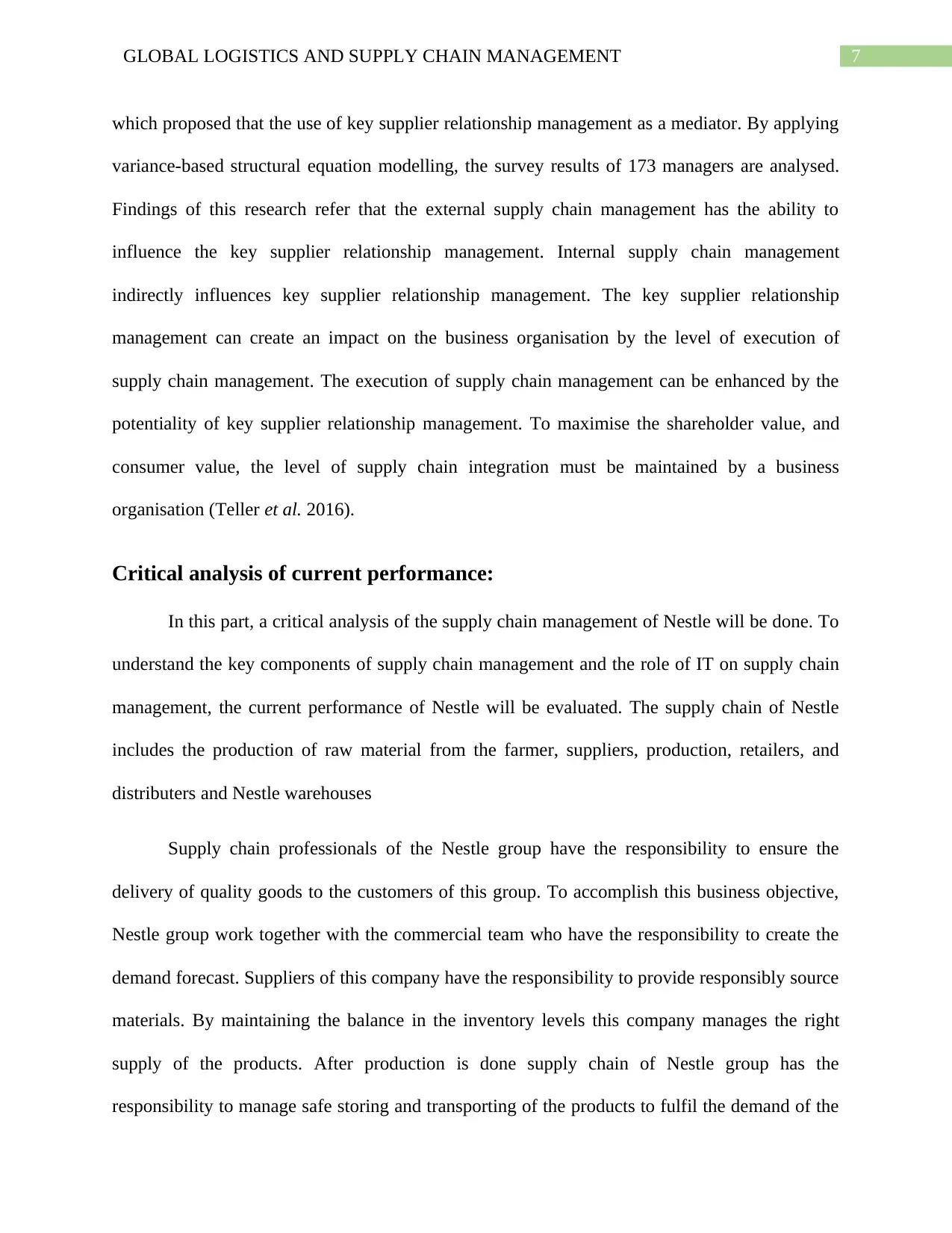
7GLOBAL LOGISTICS AND SUPPLY CHAIN MANAGEMENT
which proposed that the use of key supplier relationship management as a mediator. By applying
variance-based structural equation modelling, the survey results of 173 managers are analysed.
Findings of this research refer that the external supply chain management has the ability to
influence the key supplier relationship management. Internal supply chain management
indirectly influences key supplier relationship management. The key supplier relationship
management can create an impact on the business organisation by the level of execution of
supply chain management. The execution of supply chain management can be enhanced by the
potentiality of key supplier relationship management. To maximise the shareholder value, and
consumer value, the level of supply chain integration must be maintained by a business
organisation (Teller et al. 2016).
Critical analysis of current performance:
In this part, a critical analysis of the supply chain management of Nestle will be done. To
understand the key components of supply chain management and the role of IT on supply chain
management, the current performance of Nestle will be evaluated. The supply chain of Nestle
includes the production of raw material from the farmer, suppliers, production, retailers, and
distributers and Nestle warehouses
Supply chain professionals of the Nestle group have the responsibility to ensure the
delivery of quality goods to the customers of this group. To accomplish this business objective,
Nestle group work together with the commercial team who have the responsibility to create the
demand forecast. Suppliers of this company have the responsibility to provide responsibly source
materials. By maintaining the balance in the inventory levels this company manages the right
supply of the products. After production is done supply chain of Nestle group has the
responsibility to manage safe storing and transporting of the products to fulfil the demand of the
which proposed that the use of key supplier relationship management as a mediator. By applying
variance-based structural equation modelling, the survey results of 173 managers are analysed.
Findings of this research refer that the external supply chain management has the ability to
influence the key supplier relationship management. Internal supply chain management
indirectly influences key supplier relationship management. The key supplier relationship
management can create an impact on the business organisation by the level of execution of
supply chain management. The execution of supply chain management can be enhanced by the
potentiality of key supplier relationship management. To maximise the shareholder value, and
consumer value, the level of supply chain integration must be maintained by a business
organisation (Teller et al. 2016).
Critical analysis of current performance:
In this part, a critical analysis of the supply chain management of Nestle will be done. To
understand the key components of supply chain management and the role of IT on supply chain
management, the current performance of Nestle will be evaluated. The supply chain of Nestle
includes the production of raw material from the farmer, suppliers, production, retailers, and
distributers and Nestle warehouses
Supply chain professionals of the Nestle group have the responsibility to ensure the
delivery of quality goods to the customers of this group. To accomplish this business objective,
Nestle group work together with the commercial team who have the responsibility to create the
demand forecast. Suppliers of this company have the responsibility to provide responsibly source
materials. By maintaining the balance in the inventory levels this company manages the right
supply of the products. After production is done supply chain of Nestle group has the
responsibility to manage safe storing and transporting of the products to fulfil the demand of the
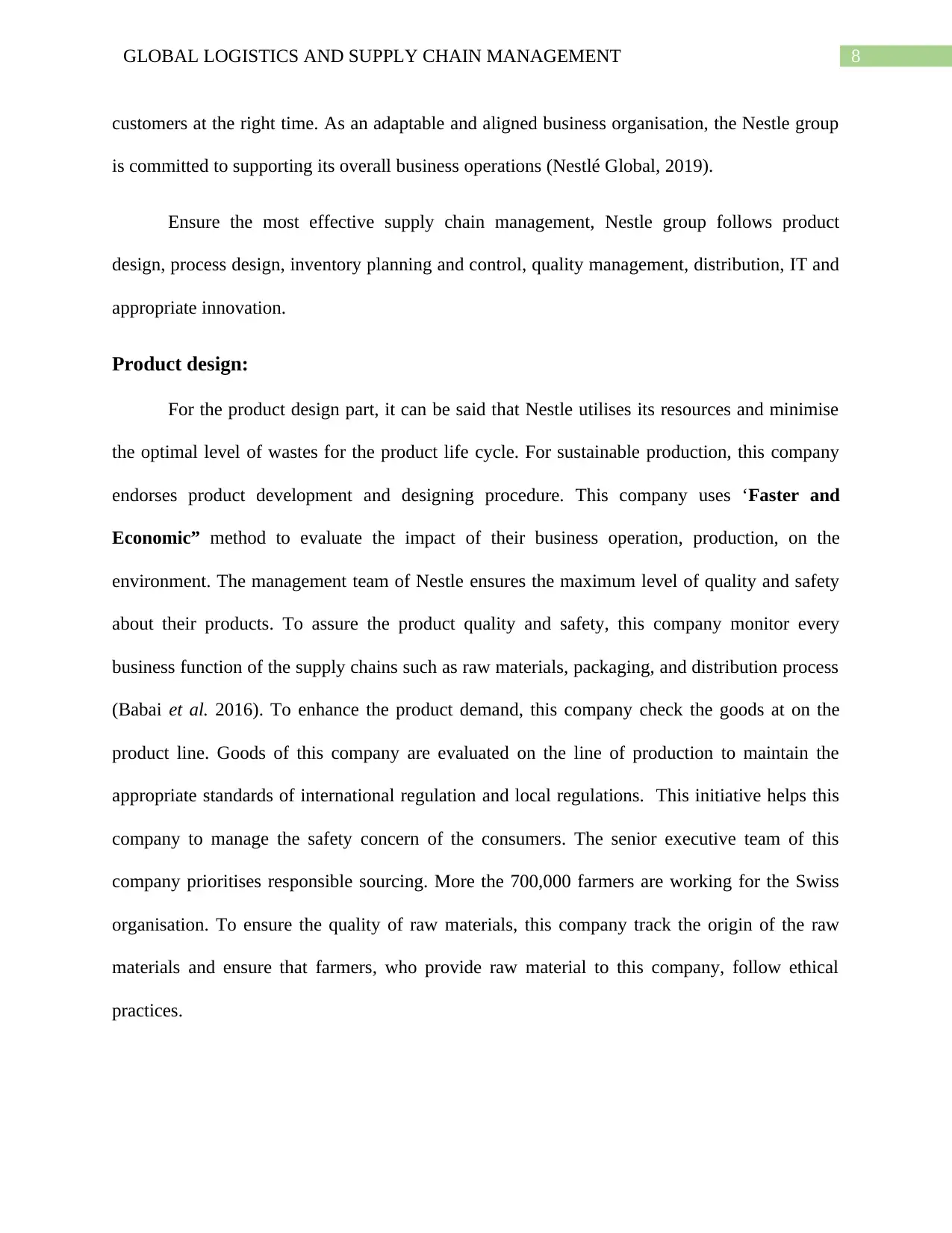
8GLOBAL LOGISTICS AND SUPPLY CHAIN MANAGEMENT
customers at the right time. As an adaptable and aligned business organisation, the Nestle group
is committed to supporting its overall business operations (Nestlé Global, 2019).
Ensure the most effective supply chain management, Nestle group follows product
design, process design, inventory planning and control, quality management, distribution, IT and
appropriate innovation.
Product design:
For the product design part, it can be said that Nestle utilises its resources and minimise
the optimal level of wastes for the product life cycle. For sustainable production, this company
endorses product development and designing procedure. This company uses ‘Faster and
Economic” method to evaluate the impact of their business operation, production, on the
environment. The management team of Nestle ensures the maximum level of quality and safety
about their products. To assure the product quality and safety, this company monitor every
business function of the supply chains such as raw materials, packaging, and distribution process
(Babai et al. 2016). To enhance the product demand, this company check the goods at on the
product line. Goods of this company are evaluated on the line of production to maintain the
appropriate standards of international regulation and local regulations. This initiative helps this
company to manage the safety concern of the consumers. The senior executive team of this
company prioritises responsible sourcing. More the 700,000 farmers are working for the Swiss
organisation. To ensure the quality of raw materials, this company track the origin of the raw
materials and ensure that farmers, who provide raw material to this company, follow ethical
practices.
customers at the right time. As an adaptable and aligned business organisation, the Nestle group
is committed to supporting its overall business operations (Nestlé Global, 2019).
Ensure the most effective supply chain management, Nestle group follows product
design, process design, inventory planning and control, quality management, distribution, IT and
appropriate innovation.
Product design:
For the product design part, it can be said that Nestle utilises its resources and minimise
the optimal level of wastes for the product life cycle. For sustainable production, this company
endorses product development and designing procedure. This company uses ‘Faster and
Economic” method to evaluate the impact of their business operation, production, on the
environment. The management team of Nestle ensures the maximum level of quality and safety
about their products. To assure the product quality and safety, this company monitor every
business function of the supply chains such as raw materials, packaging, and distribution process
(Babai et al. 2016). To enhance the product demand, this company check the goods at on the
product line. Goods of this company are evaluated on the line of production to maintain the
appropriate standards of international regulation and local regulations. This initiative helps this
company to manage the safety concern of the consumers. The senior executive team of this
company prioritises responsible sourcing. More the 700,000 farmers are working for the Swiss
organisation. To ensure the quality of raw materials, this company track the origin of the raw
materials and ensure that farmers, who provide raw material to this company, follow ethical
practices.
⊘ This is a preview!⊘
Do you want full access?
Subscribe today to unlock all pages.

Trusted by 1+ million students worldwide
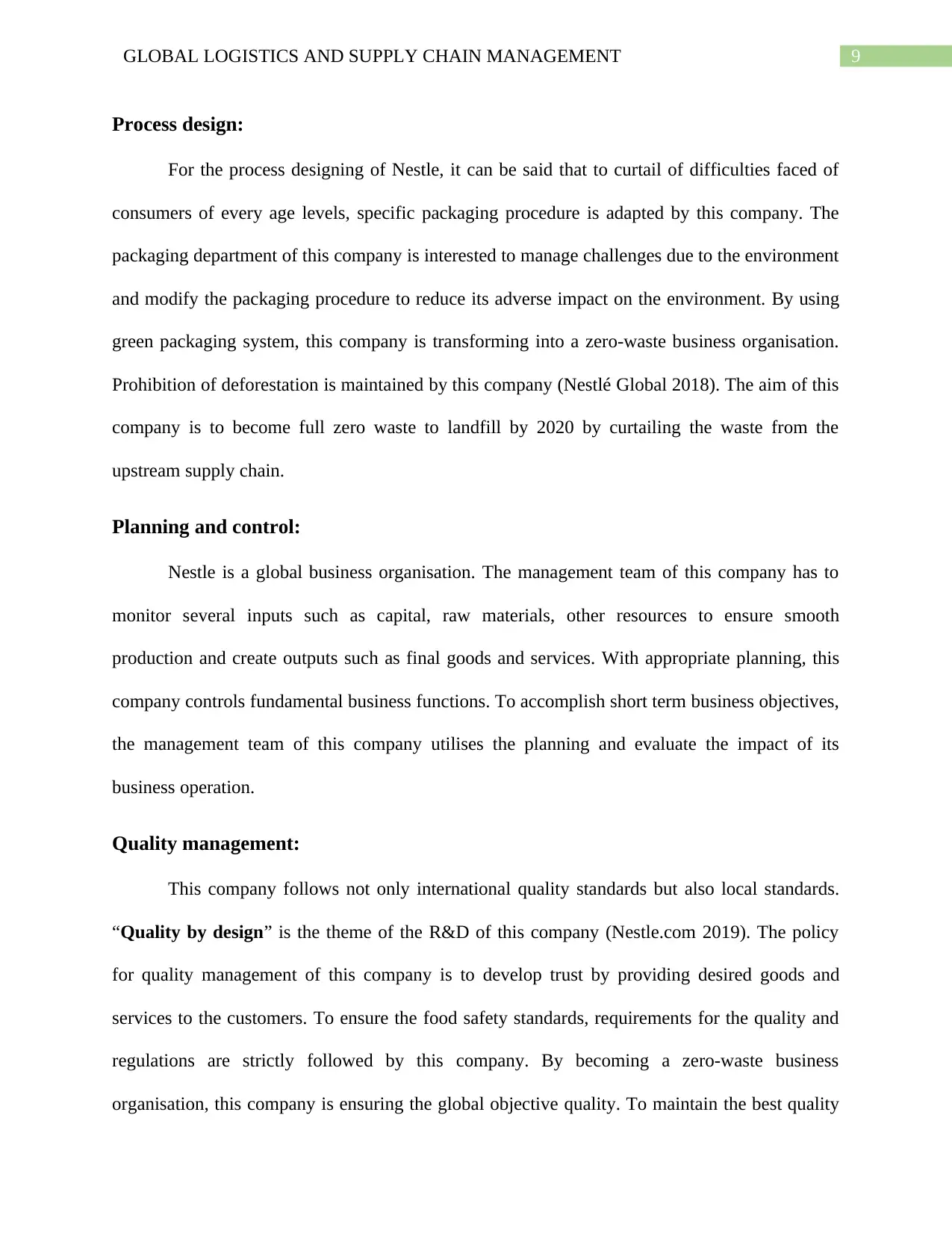
9GLOBAL LOGISTICS AND SUPPLY CHAIN MANAGEMENT
Process design:
For the process designing of Nestle, it can be said that to curtail of difficulties faced of
consumers of every age levels, specific packaging procedure is adapted by this company. The
packaging department of this company is interested to manage challenges due to the environment
and modify the packaging procedure to reduce its adverse impact on the environment. By using
green packaging system, this company is transforming into a zero-waste business organisation.
Prohibition of deforestation is maintained by this company (Nestlé Global 2018). The aim of this
company is to become full zero waste to landfill by 2020 by curtailing the waste from the
upstream supply chain.
Planning and control:
Nestle is a global business organisation. The management team of this company has to
monitor several inputs such as capital, raw materials, other resources to ensure smooth
production and create outputs such as final goods and services. With appropriate planning, this
company controls fundamental business functions. To accomplish short term business objectives,
the management team of this company utilises the planning and evaluate the impact of its
business operation.
Quality management:
This company follows not only international quality standards but also local standards.
“Quality by design” is the theme of the R&D of this company (Nestle.com 2019). The policy
for quality management of this company is to develop trust by providing desired goods and
services to the customers. To ensure the food safety standards, requirements for the quality and
regulations are strictly followed by this company. By becoming a zero-waste business
organisation, this company is ensuring the global objective quality. To maintain the best quality
Process design:
For the process designing of Nestle, it can be said that to curtail of difficulties faced of
consumers of every age levels, specific packaging procedure is adapted by this company. The
packaging department of this company is interested to manage challenges due to the environment
and modify the packaging procedure to reduce its adverse impact on the environment. By using
green packaging system, this company is transforming into a zero-waste business organisation.
Prohibition of deforestation is maintained by this company (Nestlé Global 2018). The aim of this
company is to become full zero waste to landfill by 2020 by curtailing the waste from the
upstream supply chain.
Planning and control:
Nestle is a global business organisation. The management team of this company has to
monitor several inputs such as capital, raw materials, other resources to ensure smooth
production and create outputs such as final goods and services. With appropriate planning, this
company controls fundamental business functions. To accomplish short term business objectives,
the management team of this company utilises the planning and evaluate the impact of its
business operation.
Quality management:
This company follows not only international quality standards but also local standards.
“Quality by design” is the theme of the R&D of this company (Nestle.com 2019). The policy
for quality management of this company is to develop trust by providing desired goods and
services to the customers. To ensure the food safety standards, requirements for the quality and
regulations are strictly followed by this company. By becoming a zero-waste business
organisation, this company is ensuring the global objective quality. To maintain the best quality
Paraphrase This Document
Need a fresh take? Get an instant paraphrase of this document with our AI Paraphraser
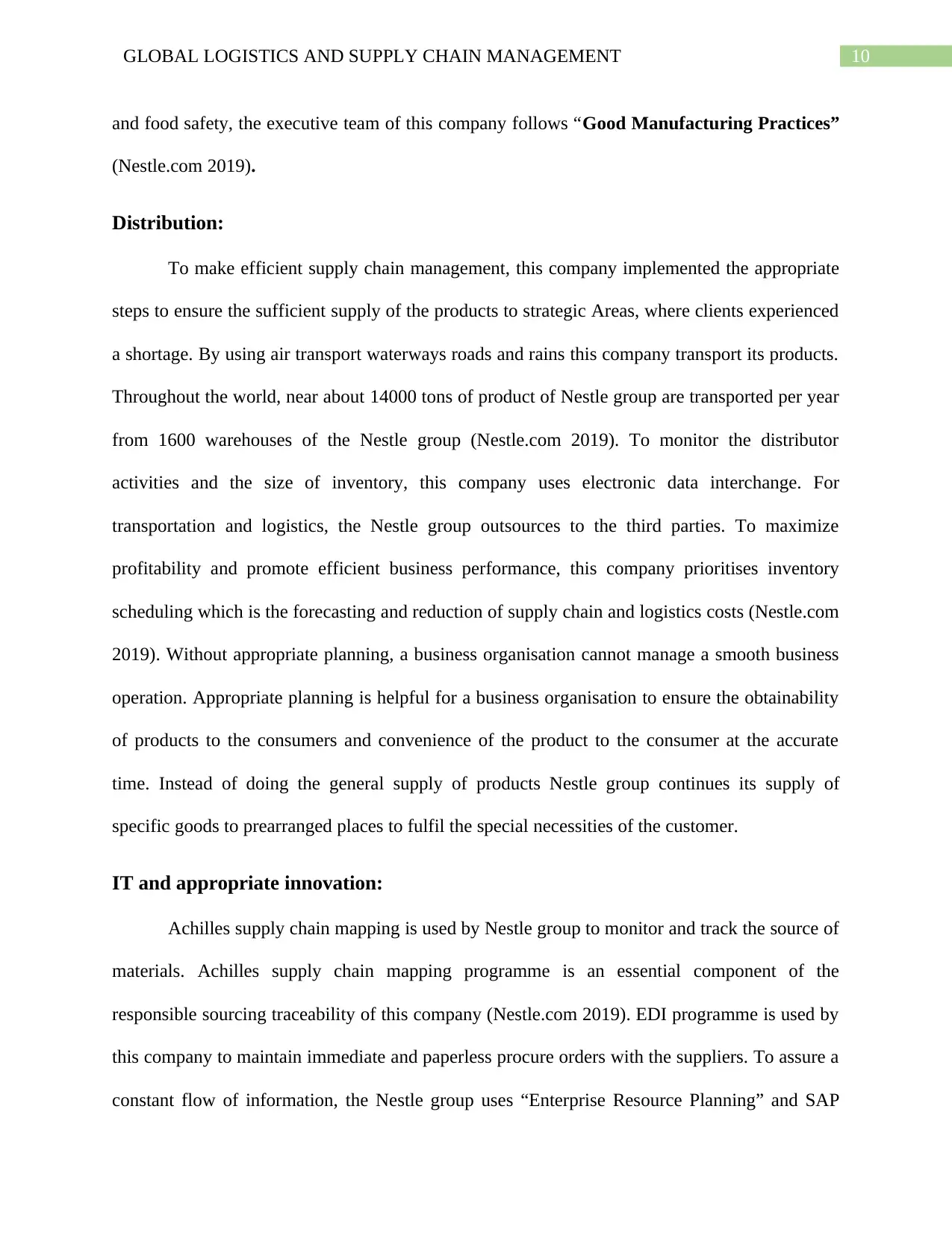
10GLOBAL LOGISTICS AND SUPPLY CHAIN MANAGEMENT
and food safety, the executive team of this company follows “Good Manufacturing Practices”
(Nestle.com 2019).
Distribution:
To make efficient supply chain management, this company implemented the appropriate
steps to ensure the sufficient supply of the products to strategic Areas, where clients experienced
a shortage. By using air transport waterways roads and rains this company transport its products.
Throughout the world, near about 14000 tons of product of Nestle group are transported per year
from 1600 warehouses of the Nestle group (Nestle.com 2019). To monitor the distributor
activities and the size of inventory, this company uses electronic data interchange. For
transportation and logistics, the Nestle group outsources to the third parties. To maximize
profitability and promote efficient business performance, this company prioritises inventory
scheduling which is the forecasting and reduction of supply chain and logistics costs (Nestle.com
2019). Without appropriate planning, a business organisation cannot manage a smooth business
operation. Appropriate planning is helpful for a business organisation to ensure the obtainability
of products to the consumers and convenience of the product to the consumer at the accurate
time. Instead of doing the general supply of products Nestle group continues its supply of
specific goods to prearranged places to fulfil the special necessities of the customer.
IT and appropriate innovation:
Achilles supply chain mapping is used by Nestle group to monitor and track the source of
materials. Achilles supply chain mapping programme is an essential component of the
responsible sourcing traceability of this company (Nestle.com 2019). EDI programme is used by
this company to maintain immediate and paperless procure orders with the suppliers. To assure a
constant flow of information, the Nestle group uses “Enterprise Resource Planning” and SAP
and food safety, the executive team of this company follows “Good Manufacturing Practices”
(Nestle.com 2019).
Distribution:
To make efficient supply chain management, this company implemented the appropriate
steps to ensure the sufficient supply of the products to strategic Areas, where clients experienced
a shortage. By using air transport waterways roads and rains this company transport its products.
Throughout the world, near about 14000 tons of product of Nestle group are transported per year
from 1600 warehouses of the Nestle group (Nestle.com 2019). To monitor the distributor
activities and the size of inventory, this company uses electronic data interchange. For
transportation and logistics, the Nestle group outsources to the third parties. To maximize
profitability and promote efficient business performance, this company prioritises inventory
scheduling which is the forecasting and reduction of supply chain and logistics costs (Nestle.com
2019). Without appropriate planning, a business organisation cannot manage a smooth business
operation. Appropriate planning is helpful for a business organisation to ensure the obtainability
of products to the consumers and convenience of the product to the consumer at the accurate
time. Instead of doing the general supply of products Nestle group continues its supply of
specific goods to prearranged places to fulfil the special necessities of the customer.
IT and appropriate innovation:
Achilles supply chain mapping is used by Nestle group to monitor and track the source of
materials. Achilles supply chain mapping programme is an essential component of the
responsible sourcing traceability of this company (Nestle.com 2019). EDI programme is used by
this company to maintain immediate and paperless procure orders with the suppliers. To assure a
constant flow of information, the Nestle group uses “Enterprise Resource Planning” and SAP
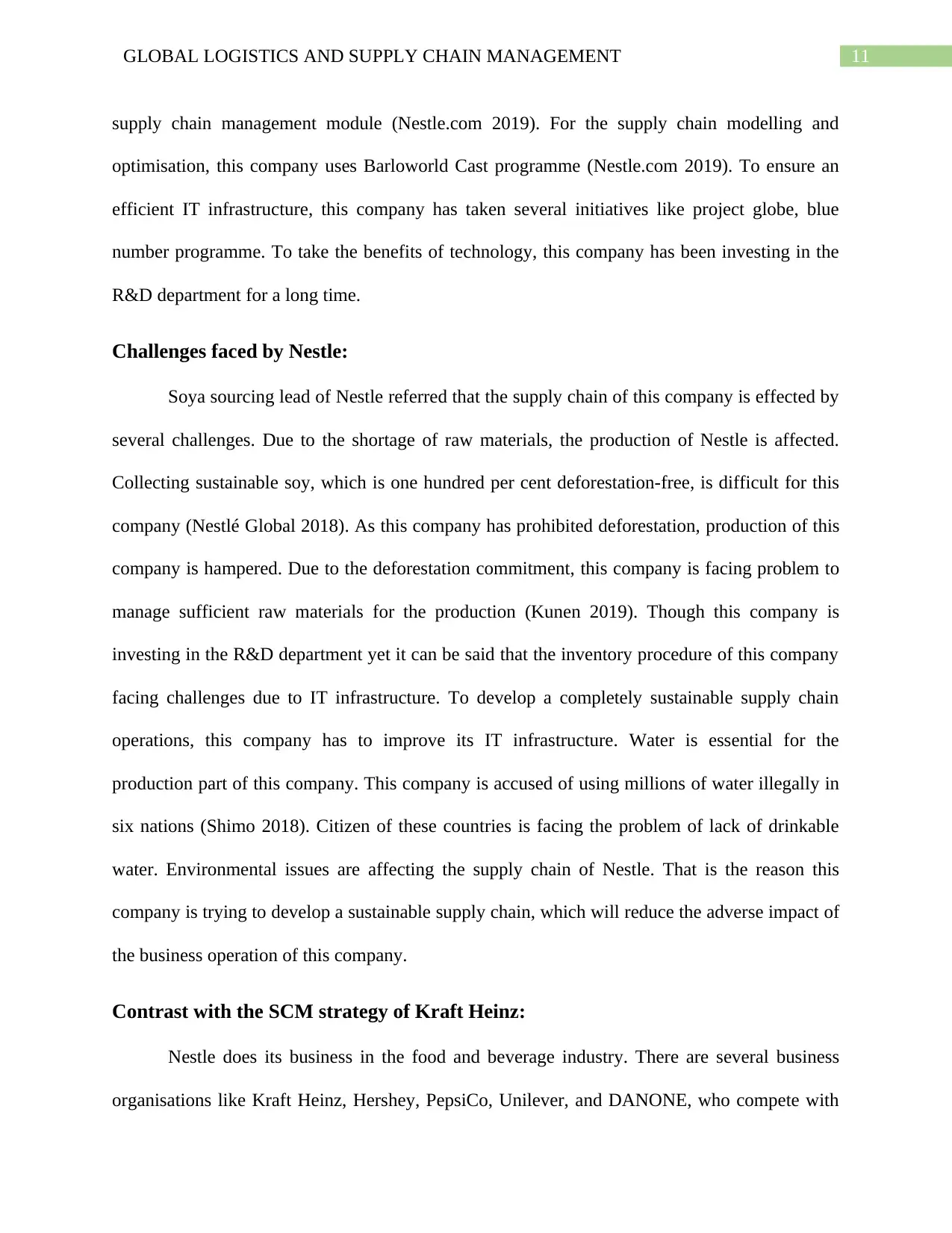
11GLOBAL LOGISTICS AND SUPPLY CHAIN MANAGEMENT
supply chain management module (Nestle.com 2019). For the supply chain modelling and
optimisation, this company uses Barloworld Cast programme (Nestle.com 2019). To ensure an
efficient IT infrastructure, this company has taken several initiatives like project globe, blue
number programme. To take the benefits of technology, this company has been investing in the
R&D department for a long time.
Challenges faced by Nestle:
Soya sourcing lead of Nestle referred that the supply chain of this company is effected by
several challenges. Due to the shortage of raw materials, the production of Nestle is affected.
Collecting sustainable soy, which is one hundred per cent deforestation-free, is difficult for this
company (Nestlé Global 2018). As this company has prohibited deforestation, production of this
company is hampered. Due to the deforestation commitment, this company is facing problem to
manage sufficient raw materials for the production (Kunen 2019). Though this company is
investing in the R&D department yet it can be said that the inventory procedure of this company
facing challenges due to IT infrastructure. To develop a completely sustainable supply chain
operations, this company has to improve its IT infrastructure. Water is essential for the
production part of this company. This company is accused of using millions of water illegally in
six nations (Shimo 2018). Citizen of these countries is facing the problem of lack of drinkable
water. Environmental issues are affecting the supply chain of Nestle. That is the reason this
company is trying to develop a sustainable supply chain, which will reduce the adverse impact of
the business operation of this company.
Contrast with the SCM strategy of Kraft Heinz:
Nestle does its business in the food and beverage industry. There are several business
organisations like Kraft Heinz, Hershey, PepsiCo, Unilever, and DANONE, who compete with
supply chain management module (Nestle.com 2019). For the supply chain modelling and
optimisation, this company uses Barloworld Cast programme (Nestle.com 2019). To ensure an
efficient IT infrastructure, this company has taken several initiatives like project globe, blue
number programme. To take the benefits of technology, this company has been investing in the
R&D department for a long time.
Challenges faced by Nestle:
Soya sourcing lead of Nestle referred that the supply chain of this company is effected by
several challenges. Due to the shortage of raw materials, the production of Nestle is affected.
Collecting sustainable soy, which is one hundred per cent deforestation-free, is difficult for this
company (Nestlé Global 2018). As this company has prohibited deforestation, production of this
company is hampered. Due to the deforestation commitment, this company is facing problem to
manage sufficient raw materials for the production (Kunen 2019). Though this company is
investing in the R&D department yet it can be said that the inventory procedure of this company
facing challenges due to IT infrastructure. To develop a completely sustainable supply chain
operations, this company has to improve its IT infrastructure. Water is essential for the
production part of this company. This company is accused of using millions of water illegally in
six nations (Shimo 2018). Citizen of these countries is facing the problem of lack of drinkable
water. Environmental issues are affecting the supply chain of Nestle. That is the reason this
company is trying to develop a sustainable supply chain, which will reduce the adverse impact of
the business operation of this company.
Contrast with the SCM strategy of Kraft Heinz:
Nestle does its business in the food and beverage industry. There are several business
organisations like Kraft Heinz, Hershey, PepsiCo, Unilever, and DANONE, who compete with
⊘ This is a preview!⊘
Do you want full access?
Subscribe today to unlock all pages.

Trusted by 1+ million students worldwide
1 out of 19
Related Documents
Your All-in-One AI-Powered Toolkit for Academic Success.
+13062052269
info@desklib.com
Available 24*7 on WhatsApp / Email
![[object Object]](/_next/static/media/star-bottom.7253800d.svg)
Unlock your academic potential
Copyright © 2020–2025 A2Z Services. All Rights Reserved. Developed and managed by ZUCOL.





